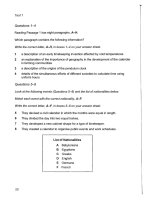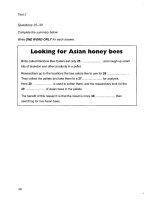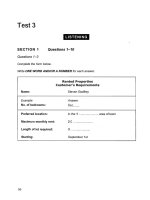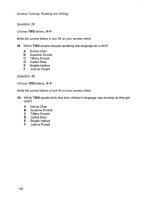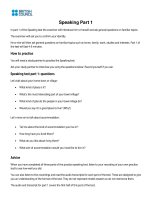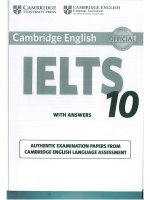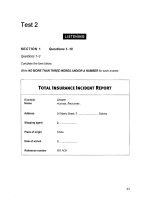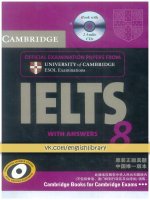Cambridge ielts 8 practice test
Bạn đang xem bản rút gọn của tài liệu. Xem và tải ngay bản đầy đủ của tài liệu tại đây (10.23 MB, 173 trang )
(
5ˆ
UNIVERSITYoģCAMBRIDGE
SOL Examinations
Ue wae
aa) SoS
5
1
Mave Sa eee
aa)
Coorswe Nee
nye
Cambridge Books for Cambridge Exams eee
Contents
4
Test 4
81
General Training: Reading and Writing Test A
104
General Training: Reading and Writing Test B
117
Tapescripts
130
Listening and Reading Answer Keys
152
Model and sample answers for Writing tasks
Sample answer sheets
Acknowledgements
162
174
176
#
56
He
Test 3
a
33
⁄
Test 2
YH
10.
/ ities
Test 1
gã
Introduction
Introduction
The International English Language Testing System (IELTS) is widely recognised as a
reliable means of assessing the language ability of candidates who need to study or work
where English is the language of communication. These Practice Tests are designed to give
future IELTS candidates an idea of whether their English is at the required level.
IELTS is owned by three partners, the University of Cambridge ESOL Examinations,
the British Council and IDP Education Pty Limited (through its subsidiary company, IELTS
Australia Pty Limited). Further information on IELTS can be found on the IELTS website
(www. ielts.org).
WHAT
IS THE TEST FORMAT?
IELTS consists of six components. All candidates take the same Listening and Speaking
tests. There is a choice of Reading and Writing tests according to whether a candidate is
~ taking the Academic or General Training module.
“For candidates wishing to study at
“undergraduate or. postgraduate. levels,
and for those seeking professional
-Tegistration.
2
_
: General Training
For candidates: wishing.
an.English- speaking Cot
Canada, New Zealand, Ub
wishing to train or study at bel
level.
The test components are taken in the following order
Listening
4 sections, 40 items
approximately 30 minutes
Academic Reading
3 sections, 40 items
60 minutes
Academic Writing
2 tasks
60 minutes
or
or
Speaking
11 to 14 minutes
Total Test Time
2 hours 44 minutes
General Training Reading ©
3 sections, 40 items
60 minutes
General Training Writing
2 tasks
60 minutes
Introduction
Listening
This test consists of four sections, each with ten questions. The first two sections are
concerned with social needs. The first section is a conversation between two speakers and
the second section is a monologue. The final two sections are concerned with situations
related to educational or training contexts. The third section is a conversation between up to
four people and the fourth section is a monologue.
A variety of question types is used, inciuding: muitipie choice, matching, plan/map/
diagram labelling, form completion, note completion, table completion, flow-chart completion,
summary completion, sentence completion, short-answer questions.
Candidates hear the recording once only and answer the questions as they listen. Ten
minutes are allowed at the end for candidates to transfer their answers to the answer sheet.
Academic Reading
This test consists of three sections with 40 questions. There are three texts, which are .
taken from journals, books, magazines and newspapers. The texts are on topics of general
interest. At least one text contains detailed logical argument.
A variety of question types is used, including: multiple choice, identifying information (True/
False/Not Given), identifying writer’s views/claims (Yes/No/Not Given), matching information, matching headings, matching features, matching sentence endings, sentence completion,
summary completion, note completion, table completion, flow-chart completion, diagram
label completion, short-answer questions.
General Training Reading
This test consists of three sections with 40 questions. The texts are taken from notices,
advertisements, leaflets, newspapers, instruction manuals, books and magazines. The
first section contains texts relevant to basic linguistic survival in English, with tasks mainly
concerned with providing factual information. The second section focuses on the work
context and invoives texts of more compiex ianguage. The third section invoives reading
more extended texts, with a more complex structure, but with the emphasis on descriptive
and instructive rather than argumentative texts.
A variety of question types is used, including: multiple choice, identifying information (True/
False/Not Given), identifying writer’s views/claims (Yes/No/Not Given), matching information,
matching headings, matching features, matching sentence endings, sentence completion,
summary completion, note completion, table completion, flow-chart completion, diagram
label completion, short-answer questions.
Academic Writing
This test consists of two tasks. It is suggested that candidates spend about 20 minutes on
Task 1, which requires them to write at least 150 words, and 40 minutes on Task 2, which
requires them to write at least 250 words. Task 2 contributes twice as much as Task 1 to the
Writing score.
Task 1 requires candidates to look at a diagram or some data (graph, table or chart) and
to present the information in their own words. They are assessed on their ability to organise,
present and possibly compare data, describe the stages of a process, describe an object or
event, or explain how something works.
Introduction
In Task 2 candidates are presented with a point of view, argument or problem. They are
assessed on their ability to present a solution to the problem, present and justify an opinion,
compare and contrast evidence and opinions, and evaluate and challenge ideas, evidence or
arguments.
Candidates are also assessed on their ability to write in an appropriate style.
This test consists of two tasks. It is suggested that candidates spend about 20 minutes on
Task 1, which requires them to write at least 150 words, and 40 minutes on Task 2, which
requires them to write at least 250 words. Task 2 contributes twice as much as Task 1 to the
Writing score.
In Task 1 candidates are asked to respond to a given situation with a letter requesting
information or explaining the situation. They are assessed on their ability to engage in
personal correspondence, elicit and provide general factual information, express needs,
wants, likes and dislikes, express opinions, complaints, etc.
In Task 2 candidates are presented with a point of view, argument or problem. They are
assessed on their ability to provide general factual information, outline a problem and present
a solution, present and justify an opinion, and evaluate and challenge ideas, evidence or
arguments.
Candidates are also assessed on their ability to write in an appropriate style.
More information on assessing both the Academic and General Training Writing tests,
including Writing Band Descriptors (public version), is available on the IELTS website.
Speaking
This test takes between 11 and 14 minutes and is conducted by a trained examiner.
There are three parts:
Part 1 ©
|
The candidate and the examiner introduce themselves. Candidates then answer general
questions about themselves, their home/family, their job/studies, their interests and a wide
range of similar familiar topic areas. This part lasts between four and five minutes.
Part 2
The candidate is given a task card with prompts and is asked to talk on a particular topic.
The candidate has one minute to prepare and they can make some notes if they wish, before
speaking for between one and two minutes. The examiner then asks one or two questions on
the same topic.
Part 3
The examiner and the candidate engage in a discussion of more abstract issues which are
thematically linked to the topic in Part 2. The discussion lasts between four and five minutes.
The Speaking test assesses whether candidates can communicate effectively in English.
The assessment takes into account Fluency and Coherence, Lexical Resource, Grammatical
6
Introduction
Range and Accuracy, and Pronunciation. More information on assessing the Speaking test,
including Speaking Band Descriptors (public version), is available on the IELTS website.
HOW IS IELTS SCORED?
IELTS results aré reported on a nine-band scale. In addition to the score for overall language
ability, IELTS provides a score in the form of a profile for each of the four skills (Listening,
Reading, Writing and Speaking). These scores are also reported on a nine-band scale. All
scores are recorded on the Test Report Form along with details of the candidate’s nationality,
first language and date of birth. Each Overall Band Score corresponds to a descriptive
statement which gives a summary of the English language ability of a candidate classified at
that level. The nine bands and their descriptive statements are as follows:
9 Expert User — Has fully operational command of the language: appropriate, accurate and
fluent with complete understanding.
8 Very Good User — Has fully operational command of the language with only occasional
unsystematic inaccuracies and inappropriacies. Misunderstandings may occur in
unfamiliar situations. Handles complex detailed argumentation well.
7 Good User — Has operational command of the language, though with occasional
inaccuracies, inappropriacies and misunderstandings in some situations. Generally
handles complex language well and understands detailed reasoning.
6 Competent User — Has generally effective command of the language despite some
inaccuracies, inappropriacies and misunderstandings. Can use and understand fairly
complex lanquage, particularly in familiar situations.
5. Modest User — Has partial command of the language, coping with overall meaning in
most situations, though is likely to make many mistakes. Should be able to handle basic
communication in own field.
4 Limited User— Basic competence is limited to familiar situations. Has frequent problems
in understanding and expression. Is not able to use complex language.
3 Extremely Limited User — Conveys and understands only general meaning in very
familiar situations. Frequent breakdowns in communication occur.
2 Intermittent User — No real communication is possible except for the most basic
information using isolated words or short formulae in familiar situations and to meet
immediate needs. Has great difficulty understanding spoken and written English.
1 Non User — Essentially has no ability to use the language beyond possibly a few isolated
words.
0 Did not attempt the test — No assessable information provided.
Introduction
Most universities and colleges in the United Kingdom, Australia, New Zealand, Canada
and the USA accept an IELTS Overall Band Score of 6.0 — 7.0 for entry to academic
programmes.
MARKING
THE PRACTICE TESTS
Listening and Reading
The Answer Keys are on pages 152-161.
Each question in the Listening and Reading tests is worth one mark.
Questions which require letter / Roman numeral answers
e For questions where the answers are letters or Roman numerals, you should write only
the number of answers required. For example, if the answer is a single letter or numeral
you should write only one answer. If you have written more letters or numerals than are
required, the answer must be marked wrong.
oeeeoeeé
®
Questions which require answers in the form of words or numbers
e Answers may be written in upper or lower case.
e Words in brackets are optional — they are correct, but not necessary.
e Alternative answers are separated by.a slash (/).
e lf you are asked to write an answer using a certain number of words and/or (a) number(s),
you will be penalised if you exceed this. For example, if a question specifies an answer
using NO MORE THAN THREE WORDS and the correct answer is ‘black leather coat’,
the answer ‘coat of black leather’ is incorrect.
e In questions where you are expected to complete a gap, you should transfer only the
necessary missing word(s) onto the answer sheet. For example, to complete ‘in the ...’,
and the correct answer is ‘morning’, the answer ‘in the morning’ would be incorrect.
All answers require correct spelling (including words in brackets).
Both US and UK spelling are acceptable and are included in the Answer Key.
All standard alternatives for numbers, dates and currencies are acceptable.
All standard abbreviations are acceptable.
You will find additional notes about individual answers in the Answer Key.
Writing
The model and sample answers are on pages 162-173. It is not possible for you to give
yourself a mark for the Writing tasks. For Task 2 in Tests 1 and 3, and Task 1 in Tests 2 and
4, and for Task 1 in General Training Test A and Task 2 in General Training Test B, we have
provided mode! answers (written by an examiner). It is important to note that these show
just one way of completing the task, out of many possible approaches. For Task 1 in Tests 1
and 3, and Task 2 in Tests 2 and 4, and for Task 2 in General Training Test A and Task 1 in
General Training Test B, we have provided sample answers (written by candidates), showing
their score and the examiner's comments. These model answers and sample answers will
give you an insight into what is required for the Writing test.
8
—
Introduction
HOW SHOULD
YOU INTERPRET YOUR SCORES?
At the end of each Listening and Reading Answer key you will find a chart which will help you
assess whether, on the basis of your Practice Test results, you are ready to take the IELTS
test.
In interpreting your score, there are a number of points you should bear in mind. Your
performance in the real IELTS test will be reported in two ways: there will be a Band Score
from 1 to 9 for each of the components and an Overall Band Score from 1 to 9, which
is the average of your scores in the four components. However, institutions considering
your application are advised to look at both the Overall Band Score and the Bands for
each component in order to determine whether you have the language skills needed for a
particular course of study. For example, if your course has a lot of reading and writing, but
no lectures, listening skills might be less important and a score of 5 in Listening might be
acceptable if the Overall Band Score was 7. However, for a course which has lots of lectures
and spoken instructions, a’score of 5 in Listening might be unacceptable even though the
Overall Band Score was 7.
Once you have marked your tests you should have some idea of whether your listening
and reading skills are good enough for you to try the IELTS test. If you did well enough in
one component but not in others, you will have to decide for yourself whether you are ready
to take the test.
The Practice Tests have been checked to ensure that they are of approximately the same
level of difficulty as the real IELTS test. However, we cannot guarantee that your score in the
Practice Tests will be reflected in the real IELTS test. The Practice Tests can only give you
an idea of your possible future performance and it is ultimately up to you to make decisions
based on your score.
Different institutions accept different IELTS scores for different types of courses. We have
based our recommendations on the average scores which the majority of institutions accept.
The institution to which you are applying may, of course, require a higher cr lower score than
most other institutions.
Further information
For more information about IELTS or any other University of Cambridge ESOL examination,
write to:
University of Cambridge ESOL Examinations _.
1 Hills Road
Cambridge
_
CB1 2EU
United Kingdom
Telephone: +44 1223 553355
Fax: +44 1223 460278
email:
http:/Awww.cambridgeesol.org
http://www. ielts.org
Test1
SECTION
1
Questions 1—10
Questions 1 and 2
Choose the correct letter, A, Bor C.
Example
In the library George found
1
A
abook.
C
anewspaper.
a brochure.
In the lobby of the library George saw
A
B=
C
2
agyroup playing music.
adisplay of instruments.
avideo about the festival.
George wants to sit at the back so they can
A
B
C
10
see well.
hear clearly.
pay less.
Listening
Questions 3-10
Complete the form below.
Write NO MORE THAN TWO WORDS ANDIOR A NUMBER for each answer.
SUMMER MUSIC FESTIVAL
BOOKING FORM
NAME:
ADDRESS:
George O'Neill
_
"
3 Q....................... , Westsea
POSTCODE:
 ..............cc.eecce.
TELEPHONE:
¬
Date
Event
5 June
Instrumental group
— Guitarrini
17 June
Singer (price
Price per ticket
No. of tickets
£7.50
2
£6
2
£7.00
1
:
includes
6...................
c... in
the garden)
22 dune
II...
23 June
Spanish Dance &
(Anna Ventura)
Guitar Concert
8Ê.......................
re
NB Children / Students / Senior Citizens have 10
tickets.
11
Test 7
SECTION
2
Questions 11-20
Questions 11-15
Complete the sentences below. °
1A/;£ ^
VVII t C
a
TYV
AP
IVIUFTY
A
“1
AIIRAD ED
iV{UiViL2L„TV
far
II
qnanhh
CƠUOI!
anawar
aliowdr,
The Dinosaur Museum
11
The museum closes at........................ p.m. on Mondays.
12
The museum is not open on ......................... .
13
School groups are met by tour guides in the .......................... .
14
The whole visit takes 90 minutes, including ......................... minutes for the
15
There are......................... behind the museum where students can have lunch.
guided tour.
Questions 16-18
Choose THREE letters, A-G.
QmmoawnyY
Which THREE things can students have with them in the museum?
12
food
water
cameras
books
bags
pens
worksheets
Listening
Questions 19 and 20
Choose
TWO letters, A-E
mogaoWwW
>
Which TWO activities can students do after the tour at present?
build model dinosaurs
watch films
draw dinosaurs
find dinosaur eggs
play computer games
13
Test 1
SECTION
3
Questions 21-30
Questions 21-24
Choose the correct letter, A, B or C.
Field Trip Proposal
21
The tutor thinks that Sandra’s proposal
A _
B
C
22
The proposal would be easier to follow if Sandra
A_
B
C
23
Separate points were not clearly identified.
The headings were not always clear.
Page numbering was not used in an appropriate way.
Sandra became interested in visiting the Navajo National Park through
A_
B
| C
14
inserted subheadings.
used more paragraphs.
shortened her sentences.
What was the problem with the formatting
on Sandra’s proposal?
A__
B
C
24
should be re-ordered in some parts.
needs a contents page.
ought to include more information.
articles she read.
movies she saw as a child.
photographs she found on the internet.
Listening
Questions 25-27
Choose THREE letters, A—G.
Ommnmoow>y>
Which THREE topics does Sandra agree to include in the proposal?
climate change
field trip activities
geographical features
impact of tourism
myths and legends
plant and animal life
social history
Questions 28-30
Complete the sentences below.
Write ONE WORD ANDIOR A NUMBER for each answer.
28
The tribal park covers......................... hectares.
29_
Sandra suggests that they share the ........................ for transport.
30
She says they could also explore the local......................... .
15
Test 1
SECTION
4
Questions 31-40
Complete the notes below.
Write ONE WORD ONLY for each answer.
cE
Studying geography helps us to understand:
¢ _ the effects of different processes on the 31......................... of the Earth
¢
the dynamic between 32.......................... and population
Two main branches of study:
°
physical features
° - human lifestyles and their 33 .........................
Specific study areas: biophysical, topographic, political, social, economic,
historical and 34.......................... geography, and also cartography
Key point: geography helps us to understand our surroundings and the
associated 35........................
hoc
What do geographers do?
°
find data — e.g. conduct censuses, collect information in the form of
346........................ using computer and satellite technology
° _ analyse data — Identify 37 ........................ , €.g. cause and effect
16
Listening
* publish findings in form of:
a) maps
—
—
—
easy to carry
.can show physical features of large and small areas
BUT a two-dimensional map will always have some 38
b) aerial photos
—
can show vegetafion problems, 39 .......................... density, ocean floor etc.
c) Landsat pictures sent to receiving stations
—
used for monitoring 40......................... conditions etc.
17
Test 1
READING
PASSAGE
1
You should spend about 20 minutes on Questions 1-13, which are based on Reading
Passage 1 below.
Our conception of time depends on the way we measure it
A
According to archaeological evidence, at least 5,000 years ago, and long before the advent
of the Roman Empire, the Babylonians began to measure time, introducing calendars
to co-ordinate communal activities, to plan the shipment of goods and, in particular, to
regulate planting and harvesting. They based their calendars on three natural cycles: the
solar day, marked by the successive periods of light and darkness as the earth rotates on
its axis; the lunar month, following the phases of the moon as it orbits the earth; and
the solar year, defined by the changing seasons that accompany our planet’s revolution
around the sun.
Before the invention of artificial light, the moon had greater social impact. And, for those
living near the equator in particular, its waxing and waning was more conspicuous than
the passing of the seasons. Hence, the calendars that were developed at the lower latitudes
were influenced more by the lunar cycle than by the solar year. In more northern climes,
however, where seasonal agriculture was practised, the solar year became more crucial. As
the Roman Empire expanded northward, it organised its activity chart for the most part
around the solar year.
Centuries before the Roman Empire, the Egyptians had formulated a municipal calendar
having 12 months of 30 days, with five days added to approximate the solar year. Each
period of ten days was marked by the appearance of special groups of stars called decans.
At the rise of the star Sirius just before sunrise, which occurred around the all-important
annual flooding of the Nile, 12 decans could be seen spanning the heavens. The cosmic
significance the Egyptians placed in the 12 decans led them to develop a system in which
each interval of darkness (and later, each interval of daylight) was divided into a dozen
equal parts. These periods became known as temporal hours because their duration varied
according to the changing length of days and nights with the passing of the seasons.
Summer hours were long, winter ones short; only at the spring and autumn equinoxes
18
Reading
were the hours of daylight and darkness equal. Temporal hours, which were first adopted
by the Greeks and then the Romans, who disseminated them through Europe, remained
in use for more than 2,500 years.
In order to track temporal hours during the day, inventors created sundials, which indicate
time by the length or direction of the sun’s shadow. The sundial’s counterpart, the water
clock, was designed to measure temporal hours at night. One of the first water clocks
was a basin with a small hole near the bottom through which the water dripped out. The
falling water level denoted the passing hour as it dipped below hour lines inscribed on the
inner surface. Although these devices performed satisfactorily around the Mediterranean,
they could not always be depended on in the cloudy and often freezing weather of
northern Europe.
The advent of the mechanical clock meant that although it could be adjusted to maintain
temporal hours, it was naturally suited to keeping equal ones. With these, however, arose
the question of when to begin counting, and so, in the early 14th century, a number of
systems evolved. The schemes that divided the day into 24 equal parts varied according
to the start of the count: Italian hours began at sunset, Babylonian hours at sunrise,
astronomical hours at midday and ‘great clock’ hours, used for some large public clocks
in Germany, at midnight. Eventually these were superseded by ‘small clock’, or French,
hours, which split the day into two 12-hour periods commencing at midnight.
The earliest recorded weight-driven mechanical clock was built in 1283 in Bedfordshire
in England. The revolutionary aspect of this new timekeeper was neither the descending
weight that provided its motive force nor the gear wheels (which had been around for at
least 1,300 years) that transferred the power; it-was the part called the escapement. In the
early 1400s came the invention of the coiled spring or fusee which maintained constant
force to the gear wheels of the timekeeper despite the changing tension of its mainspring.
By the 16th century, a pendulum clock had been devised, but the pendulum swung in a
large arc and thus was not very efficient.
|
To address this, a variation on the original escapement was invented in 1670, in England.
It was called the anchor escapement, which was a lever-based device shaped like a ship’s
anchor. The motion of a pendulum rocks this device so that it catches and then releases
each tooth of the escape wheel, in turn allowing it to turn a precise amount. Unlike
the original form used in early pendulum clocks, the anchor escapement permitted the
pendulum to travel in a very small arc. Moreover, this invention allowed the use of a long
pendulum which could beat once a second and thus led to the development of a new floorstanding case design, which became known as the grandfather clock.
Today, highly accurate timekeeping instruments set the beat for most electronic devices.
Nearly all computers contain a quartz-crystal clock to regulate their operation. Moreover,
not only do time signals beamed down from Global Positioning System satellites calibrate
the functions of precision navigation equipment, they do so as well for mobile phones,
instant stock-trading systems and nationwide power-distribution grids. So integral have
these time-based technologies become to day-to-day existence that our dependency on
them is recognised only when they fail to work.
19
Test 1
Questions 1-4
Reading Passage 1 has eight paragraphs, A-H.
Which paragraph contains the following information?
Write the correct ietter, A-H, in boxes 1-4 on your answer sheet.
1
adescription of an early timekeeping invention affected by cold temperatures
2
an explanation of the importance of geography in the development of the calendar
in farming communities
a description of the origins of the pendulum clock
4
details of the simultaneous efforts of different societies to calculate time using
uniform hours
Questions 5-8
Look at the following events (Questions 5-8) and the list of nationalities below.
Match each event with the correct nationality, A-F.
Write the correct letter, A-F, in boxes 5-8 on your answer sheet.
5
They devised a civil calendar in which the months were equal in length.
6
They divided the day into two equal halves.
7
They deveioped a new cabinet shape for a type of timekeeper.
8
They created a calendar to organise public events and work schedules.
Babylonians
Egyptians
"mm
Ơ
œ@)›
A_
DW
List of Nationalities
20
Greeks
English
Germans
French
Reading
Questions 9-13
Label the diagram below.
Choose NO MORE THAN TWO WORDS from the passage for each answer.
Write your answers in boxes 9-73 on your answer sheet.
VAs.74£.~
..
How the 1670 lever-based device worked
J
escapement (resembling
small arc
21
